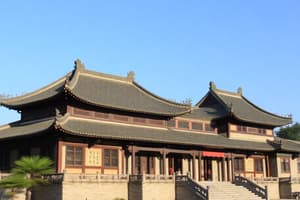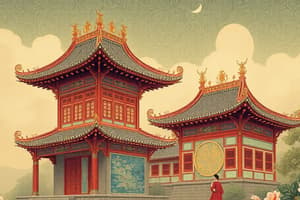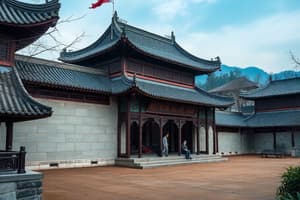Podcast
Questions and Answers
What was the duration of the Song Dynasty?
What was the duration of the Song Dynasty?
- 840-960
- 500-700
- 960-1279 (correct)
- 1300-1400
What was the Grand Canal?
What was the Grand Canal?
An internal waterway transportation system that extended over 30,000 miles.
What is Champa rice?
What is Champa rice?
A fast-ripening and drought-resistant strain of rice from the Champa Kingdom.
What is the tributary system?
What is the tributary system?
What does Kowtow refer to?
What does Kowtow refer to?
Who were the scholar gentry?
Who were the scholar gentry?
What was foot binding?
What was foot binding?
What is Zen Buddhism also known as?
What is Zen Buddhism also known as?
Define filial piety.
Define filial piety.
What is Neo-Confucianism?
What is Neo-Confucianism?
What does Sinification refer to?
What does Sinification refer to?
The Song Dynasty's bureaucracy became known as a __________.
The Song Dynasty's bureaucracy became known as a __________.
How did the Song Dynasty's imperial bureaucracy represent political continuity?
How did the Song Dynasty's imperial bureaucracy represent political continuity?
How did the imperial bureaucracy change over time?
How did the imperial bureaucracy change over time?
How did Song China utilize Confucianism to maintain control?
How did Song China utilize Confucianism to maintain control?
What led to the decline of the Song Dynasty?
What led to the decline of the Song Dynasty?
What lasting impact did the Tang Dynasty have on the Song Dynasty?
What lasting impact did the Tang Dynasty have on the Song Dynasty?
How did the Grand Canal contribute to Song China's economic success?
How did the Grand Canal contribute to Song China's economic success?
What major trade network allowed China to trade items with Eurasia?
What major trade network allowed China to trade items with Eurasia?
Key innovations in agriculture included the use of __________ to improve soil quality.
Key innovations in agriculture included the use of __________ to improve soil quality.
What were some examples of trade items from Song China?
What were some examples of trade items from Song China?
What does commercialization mean for an economy?
What does commercialization mean for an economy?
How did Song China continue to rely on free peasant and artisan labor?
How did Song China continue to rely on free peasant and artisan labor?
How did the Tributary System support both economic and political power for Song China?
How did the Tributary System support both economic and political power for Song China?
What was the difference in urbanization during Song China compared to earlier periods?
What was the difference in urbanization during Song China compared to earlier periods?
From most powerful to least powerful, the six classes of social hierarchy are __________.
From most powerful to least powerful, the six classes of social hierarchy are __________.
What evidence is there that Chinese society was patriarchal?
What evidence is there that Chinese society was patriarchal?
What inventions allowed for the flourishing of literature in the Song Dynasty?
What inventions allowed for the flourishing of literature in the Song Dynasty?
How did Buddhism migrate to China?
How did Buddhism migrate to China?
What do the three main types of Buddhism have in common?
What do the three main types of Buddhism have in common?
How is Zen Buddhism a syncretic religion?
How is Zen Buddhism a syncretic religion?
How did the Song Dynasty treat Buddhism?
How did the Song Dynasty treat Buddhism?
What similarities does Japan share with China?
What similarities does Japan share with China?
What similarities exist between Korea and China?
What similarities exist between Korea and China?
What similarities and differences exist between Vietnam and China?
What similarities and differences exist between Vietnam and China?
Flashcards are hidden until you start studying
Study Notes
Song Dynasty
- Chinese dynasty that lasted from 960 to 1279, known for its cultural prosperity and bureaucratic expansion.
- Ruled a smaller region due to invasions from Manchurian pastoralists.
- Emperors, particularly Song Taizu, promoted educational opportunities for lower economic classes through civil service exams.
- The expansion of bureaucratic positions led to increased government costs and weakened China's overall wealth.
- Agriculture advancements saw China's population grow from about 25% to nearly 40% of the world population.
Grand Canal
- An extensive internal waterway transportation system over 30,000 miles long.
- Significant in making China the world's most populous trading area during the Song Dynasty.
Champa Rice
- Fast-ripening and drought-resistant rice strain from the Champa Kingdom (modern-day Vietnam).
- Revolutionized agricultural production in China, allowing cultivation in previously unsuitable lands.
Tributary System
- Arrangements in which other states paid tribute to honor the Chinese emperor, helping assert China's economic and political authority.
- Created stability and promoted trade among tributary states, including Japan and Korea.
Kowtow
- A formal gesture of respect where individuals bowed their heads to the floor when greeting the emperor.
- Expected from representatives of tributary states.
Scholar Gentry
- The highest social class in China, educated in Confucian philosophy and highly influential in societal matters.
Foot Binding
- A cultural practice among aristocratic families starting at a young age, aimed at creating tightly bound feet.
- Considered a marker of social status and beauty; restricted women's mobility and public participation.
- Banned in 1912 due to its oppressive nature.
Zen Buddhism
- Also called Chan Buddhism, it blends Buddhist doctrines with Daoist elements.
- Focuses on personal experience and meditation rather than traditional scripture study.
Filial Piety
- A cultural norm within Confucianism requiring family members to prioritize the male head of the family’s needs over their own.
Neo-Confucianism
- A syncretic philosophy that emerged between 770 and 840, merging rational thought with Taoist and Buddhist concepts.
- Gained popularity in East Asian countries like Japan, Korea, and Vietnam.
Sinification
- The process by which non-Chinese societies adopt Chinese cultural elements, despite efforts to maintain their own cultural identity.
Imperial Bureaucracy/Meritocracy
- An organizational structure where appointed officials enforce imperial policies, primarily established since the Qin dynasty.
- The Song Dynasty's meritocracy allowed individuals to rise based on examination performance, leading to more educational opportunities for lower classes.
Economic and Political Control
- Utilized Confucianism to reinforce hierarchical family structures, ensuring loyalty to rulers and maintaining societal order.
- Expanded bureaucratic positions increased government expense, contributing to the Song’s eventual decline.
Agricultural Innovations
- Farmers implemented manure, built irrigation systems, and used water buffalo in plowing, leading to increased productivity.
- Innovations resulted in food abundance, spurring population growth.
Trade Networks
- The Silk Roads facilitated trade across Eurasia, while maritime innovations like the Grand Canal and new navigation techniques improved sea trade.
Commercialization
- Transition from local consumption to market-oriented production, enhancing economic dynamism.
Patriarchal Society
- Evidence includes Confucian emphasis on women's subordination and practices like foot binding.
Intellectual Pursuits
- Advances in printing technology from the 7th century enabled broader access to literature and knowledge for the elite, fueling Confucian scholarship.
Cultural Exchanges: Japan, Korea, Vietnam
- Japan adopted Confucian ideals and woodblock printing but maintained unique political structures.
- Korea imitated Chinese governance and culture but later developed its own writing system and hierarchical power structure.
- Vietnam implemented merit-based bureaucracy while granting women more independence in marriage compared to Chinese norms.
Studying That Suits You
Use AI to generate personalized quizzes and flashcards to suit your learning preferences.




